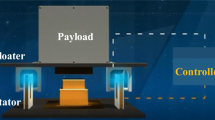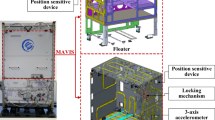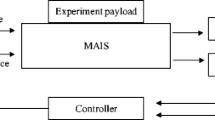Abstract
The Microgravity Active vibration Isolation System (MAIS), which was onboard China’s first cargo-spacecraft Tianzhou-1 launched on April 20, 2017, aims to provide high-level microgravity at an order of 10-5–10-6 g for specific scientific experiments. MAIS is mainly composed of a stator and a floater, and payloads are mounted on the floater. Sensing relative motion with respect to the stator fixed on the spacecraft, the floater is isolated from vibration on the stator via control forces and torques generated by electromagnetic actuators. This isolation results in a high-level microgravity environment. Before MAIS was launched into space, its control performance had been simulated on computers and tested by air-bearing platform levitation and aircraft parabolic flight. This article first presents an overview of the MAIS’s hardware system, particularly system structure, measurement sensors, and control actuators. Its system dynamics, state estimation, and control laws are then discussed, followed by the results of computer simulation and engineering tests, including the test of the six-degree-of-freedom motion by aircraft parabolic flight. Simulation and test results verify the accuracy of the control strategy design, effectiveness of the control algorithms, and performance of the entire control system, paving the way for operation of MAIS in space. This article also presents the steps recommended for the control performance simulation and tests of MAIS-like devices. These devices are expected to be used on China’s Space Station for various scientific experiments that require a high-level microgravity environment.
Similar content being viewed by others
Change history
11 February 2022
A Correction to this paper has been published: https://doi.org/10.1007/s42064-022-0136-2
References
DeLombard, R., Hrovat, K., Kelly, E., McPherson, K. Microgravity environment on the international space station. The 42nd AIAA Aerospace Sciences Meeting and Exhibit, 2004.
Stabile, A., Aglietti, G. S., Richardson, G., Smet, G. Design and verification of a negative resistance electromagnetic shunt damper for spacecraft micro-vibration. Journal of Sound and Vibration, 2017, 386: 38–49.
Liu, T. Y., Wu, Q. P., Sun, B. Q., Han, F. T. Microgravity level measurement of the Beijing drop tower using a sensitive accelerometer. Scientidic Reports, 2016, 6: 31632.
Shelhamer, M. Parabolic flight as a space ight analog. Journal of Applied Physiology, 2016, 120(12): 1442–1448.
Fuhrmann, E., Dreyer, M. Description of the sounding rocket experiment–SOURCE. Microgravity Science and Technology, 2008, 20(3–4): 205–212.
Hu, W. R., Zhao, J. F., Long, M., Zhang, X. W., Liu, Q. S., Hou, M. Y., Kang, Q., Wang, Y. R., Xu, S. H., Kong, W. J., Zhang, H., Wang, S. F., Sun, Y. Q., Hang, H. Y., Huang, Y. P., Cai, W. M., Zhao, Y., Dai, J. W., Zheng, H. Q., Duan, E. K., Wang, J. F. Space program SJ-10 of microgravity research. Microgravity Science and Technology, 2014, 26(3): 159–169.
DeLombard, R. Assessment of microgravity environment requirements for microgravity payloads. Microgravity Environment Discipline Scientist Glenn Research Center, 2004.
Boeing Defense & Space Group, Missiles & Space Division. System specification for the international space station. NASA Space Station Program Offce, Johnson Space Center, Houston, Texas, 1996.
Platz, R., Enss, G. C. Comparison of uncertainty in passive and active vibration isolation. Model Validation and Uncertainty Quantification, Volume 3, 2015, 15–25.
Grodsinsky, C. M., Whorton, M. S. Survey of active vibration isolation systems for microgravity applications. Journal of Spacecraft and Rockets, 2000, 37(5): 586–596.
Bushnell, G. S., Fialho, I. J., Allen, J. L., Quraishi, N. Microgravity flight characterization of the international space station active rack isolation system. Proceedings of SPIE 5052, Smart Structures and Materials 2003, 2003, 253–264.
Edberg, D., Boucher, R., Schenck, D., Nurre, G., Whorton, M., Kim, Y., Alhorn, D. Results of the STABLE microgravity vibration isolation flight experiment. AAS 96–071, Univelt Incorporated, 1996.
NASA Facts. Active rack isolation system (ARIS). National Aeronautics and Space Administration, 2015. https://doi.org/www.nasa.gov/centers/marshall/pdf/115938main_ARIS_FS.pdf.
Whorton, M. S. g-LIMIT-A microgravity vibration isolation system for the international space station. Proceedings of 2001 Conference and Exhibit on International Space Station Utilization, 2001.
Duval, W. M. B., Tryggvason, B. V. Effects of G-jitter on interfacial dynamics of two miscible liquids: application of MIM. NASA Center for Aerospace Information, NASA/TM2000-209789, 2000.
Casgrain, C., Dejmek, M., Ruel, S., Vachon, E. The Canadian space agency microgravity sciences program overview. Proceedings of the 42nd AIAA Aerospace Sciences Meeting and Exhibit, 2004.
Labib, M., Piontek, D., Valsecchi, N., Griffth, B., Dejmek, M., Jean, I., Mailloux, M., Palardy, R. The fluid science laboratorys microgravity vibration isolation subsystem overview and commissioning update. Proceedings of SpaceOps 2010 Conference, 2010.
Herring, R. A., Gregory, P. R. CSAs ISS MIM base unit for the EXPRESS rack. AIP Conference Proceedings, 2000, 504: 611–613.
Ren, W. J., Li, Z. F., Gao, Y. Microgravity active vibration isolation system for space science in China. Proceedings of the 61st International Astronautical Congress, 2010.
Sechi, G., Buonocore, M., Cometto, F., Saponara, M., Tramutola, A., Vinai, B., Andrè, G., Fehringer, M. Inight results from the drag-free and attitude control of GOCE satellite. Proceedings of the 18th IFAC World Congress, 2011, 733–741.
Amaro-Seoane, P., Audley, H., Babak, S., Baker, J., Barausse, E., Bender, P., Berti, E., Binetruy, P., Born, M., Bortoluzzi, D. et al. Laser interferometer space antenna. Tp.umu.se, 2017, 548(3): 411.
Liu, W., Li, Z. F., Dong, W. B., Wang, W. B., Peng, C. Modelling and simulation for microgravity active vibration isolation platform in space station. Proceedings of the 65th IAC IAC-14-a2.5.4, 2014.
Hampton, R. D., Calhoun, P. C., Whorton, M. S. Glovebox integrated microgravity isolation technology (g-limit): a linearized state-space model. AIAA 2004–784, AIAA, 2004.
Li, P., Ren, W. J., Li, Z. F. Design of the static calibration test system for Lorentz actuators in space application. Chinese Journal of Space Science, 2013, 33(1): 92–100. (in Chinese)
Tryggvason, B. V., Duval, W. M. B., Smith, R. W., Rezkallah, K. S., Varma, S., Redden, R. F., Herring, R. A. The vibration environment on the international space station: ITS significance to fluid-based experiments. Acta Astronautica, 2001, 48(2–3): 59–70.
Pletser, V. Are aircraft parabolic flights really parabolic? Acta Astronautica, 2013, 89: 226–228.
Pletser, V., Rouquette, S., Friedrich, U., Clervoy, J. F., Gharib, T., Gai, F., Mora, C. European parabolic flight campaigns with Airbus ZERO-G: looking back at the A300 and looking forward to the A310. Advances in Space Research, 2015, 56(5): 1003–1013.
Pletser, V., Rouquette, S., Friedrich, U., Clervoy, J. F., Gharib, T., Gai, F., Mora, C. The first European parabolic flight campaign with the airbus A310 ZERO-G. Microgravity Science and Technology, 2016, 28(6): 587–601.
Zhang, Y. K., Dong, W. B., Liu, W., Li, Z. F., Lv, S. M., Sang, X. R., Yang, Y. Verification of the microgravity active vibration isolation system based on parabolic flight. Microgravity Science and Technology, 2017, 29(6): 415–426.
Acknowledgements
The authors gratefully acknowledge DLR for providing us the opportunity to attend the 27th parabolic flight campaign and Novespace for the support for the test of MAIS by the Airbus A310 ZERO-G. The authors would also like to thank Weijia Ren, Xiaoru Sang, Shimeng Lv, Peng Yang, Yu-e Gao, Lingcai Song, Mengxi Yu, Boqi Kang, Yanlin Zhou, and Anping Wang, who have contributed significantly to the MAIS project.
Author information
Authors and Affiliations
Corresponding author
Additional information
Wei Liu received his B.S. and M.S. degrees in spacecraft dynamics and control from Beijing Institute of Technology, China, in 2010 and 2013, respectively. He is studying for a doctoral degree at the University of Chinese Academy of Sciences. Since 2013, he has joined Technology and Engineering Center for Space Utilization, Chinese Academy of Sciences. His academic interest includes spacecraft dynamics and control, microgravity active vibration isolation control, and drag-free control.
Yongkang Zhang received his B.S., M.S. and Ph.D. from the University of Science and Technology, China, majoring in control science and control engineering. He is currently an associate research fellow at Technology and Engineering Center of Space Utilization, Chinese Academy of Sciences. He has participated in many space utilization missions for China Manned spacecraft program. His research interests include intelligent motion control, high-reliability mechatronics.
Zongfeng Li received his Ph.D. in computing application technology from Chinese Academy of Sciences. Since 2010, he has joined Technology and Engineering Center for Space Utilization, Chinese Academy of Sciences. His academic interest includes microgravity active vibration isolation control, space structure and mechanism.
Wenbo Dong received his B.S. and M.S. degrees from Tsinghua University and received his Ph.D. degree from Institute of Automation, Chinese Academy of Sciences. He is currently an associate research professor at Technology and Engineering Center of Space Utilization, Chinese Academy of Sciences. He has participated in many space utilization missions for China Manned Spacecraft Program, and is the principle investigator of MAIS in TZ-1. His research interests include microgravity facilities, high-reliability mechatronics and control system in microgravity.
Rights and permissions
About this article
Cite this article
Liu, W., Zhang, Y., Li, Z. et al. Control performance simulation and tests for Microgravity Active vibration Isolation System onboard the Tianzhou-1 cargo spacecraft. Astrodyn 2, 339–360 (2018). https://doi.org/10.1007/s42064-018-0028-7
Received:
Accepted:
Published:
Issue Date:
DOI: https://doi.org/10.1007/s42064-018-0028-7




